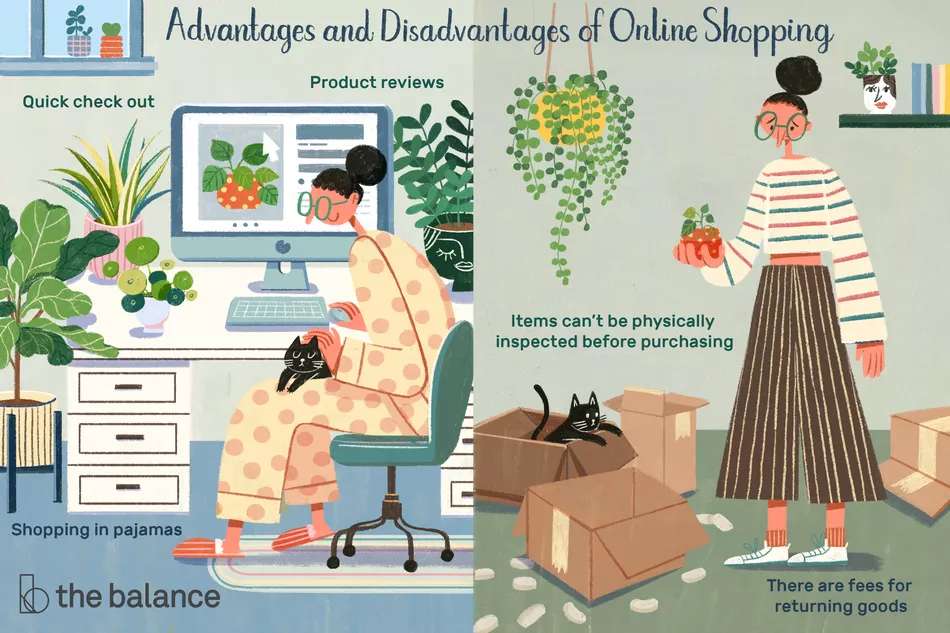Shopping for goods and services online offers myriad benefits, such as efficiency, convenience, and greater selection, as well as potentially better pricing than what you’d find in a brick-and-mortar shop.
Its popularity shows no sign of slowing, especially when social media is becoming a strong platform for shopping, too. Commerce driven by social media is expected to reach $36 billion in 2021, representing 4.3% of all retail commerce sales, according to a recent report from Insider Intelligence.3
Even though it’s easy to overindulge in retail therapy and overspend, the benefits of online shopping tend to outweigh the negatives if you know how to shop smart. Learn how to enjoy the benefits of online shopping and how to avoid e-commerce scams.
Pros of Online Shopping
Hassle-Free Sales
Googling for deals is undoubtedly one of e-commerce’s biggest perks: You avoid sometimes-pushy salespeople and crowds, all from the comfort of your couch. Plus, it’s easier to browse the latest sales all at once rather than pushing through racks.
Product Reviews
Online reviews make it easy to get insider information on the product or shop you’re interested in. Clothing rental service Nuuly, for example, lets its customers add photos of themselves wearing products to written reviews, enabling future customers to make empowered, smart purchasing decisions.4 It’s beneficial for small businesses, too. Eighty-seven percent of consumers read online reviews of local businesses, according to marketing consultancy BrightLocal’s 2020 Local Consumer Review Survey.5
Free Shipping
When applicable, free shipping is a key driver for online purchases. Free shipping leads to more sales, according to a recent survey conducted by Austin, Texas-based BigCommerce. Eighty-four percent of respondents reported specifically making a purchase because free shipping was offered, and 77% of consumers said they have abandoned a purchase as a result of “unsatisfactory” shipping options.6 Amazon Prime is an appealing service for many due to its guaranteed free, two-day shipping.7
Cons of Online Shopping
Return Fees
Many return policies often require you to pay for refund and restocking fees, even for defective items, according to Michelle Madhok, online shopping expert and founder of online deals publication, SHEFinds Media. If a company does not provide you with a return shipment label, you will have to pay out of pocket for the expenses at a postal service.
When using a credit card to make online purchases, keep track of your spending. By consistently reviewing your monthly statement and maintaining your receipts, you’ll be able to better monitor your spending habits, and also be aware of potential fraud or mischarges.
Sales Tax and Other Fees
Be prepared to pay for convenience. Not all products purchased online are taxable, but items like jewelry and clothing generally are. Plus, international and interstate shipping charges can make purchases more pricey. When you make a purchase from Etsy—the popular e-commerce website for makers and creators across the globe—for example, sellers have to pay a 5% transaction fee that they may add into the price of the item you purchased.
Higher Chance of Fraud
Beware of sites that request more personal information than just your name, address, and credit card number. According to the Federal Trade Commission (FTC), there were 4.8 million identify theft and fraud reports in 2020, most of which occurred online.9 If an online site asks for something like your social security number or bank account number, that’s typically a red flag that where you’re shopping from is not trustworthy and you may be a victim of fraud.
Millennials, or those in their high 20s and 30s, are 25% more likely to lose money as a result of online fraud than those 40 or older, while people over age 40 are more likely to lose larger sums of money when they are targeted with phone and tech support scams.10
Tips for Making the Most of Online Shopping
Online shopping thrives off the desire for convenience, but it can often be overshadowed by the faults. To ensure your experience with e-commerce is a positive one, consider the following actions.
Buy Direct
One of the downsides of not visiting a store in person is that you build a digital rapport with a business instead of having an in-person experience with shop owners. Because of this, it’s important to know who you are buying from and to identify all of the necessary details surrounding the product you want to purchase.
No matter which service you use, read the fine print to be aware of return policies, taxes, and any other fees. Often, if you buy direct instead of going through a third-party source, you can reduce the cost of additional fees.
Protect Yourself From Fraud
If you suspect suspicious activity on your account, first check in with your bank to verify it. Next, contact the FTC, the Better Business Bureau (BBB), or your state’s consumer protection agency to file a complaint. Madhok recommends always paying by credit card online, as credit card’s often provide zero-liabilitypolicies that don’t hold you responsible for most fraudulent charges.
The FTC warns that email is not a secure method of sending credit card, checking account, or Social Security numbers to an online retailer.11 If a company asks you to email them your financial information, consider that a red flag.
It Pays To Compare
Registering for sales alerts via websites like eBay and ShopStyle, for example, can let you know when the price of an item changes, making comparison shopping and savings easy. Also, don’t assume that Amazon always has an item for less than competitors. “During the coronavirus, things like toilet paper became more expensive through third-party sellers,” Madhok said. “It’s best to go to Costco for those things.”
Build a Relationship With Companies
If there are certain businesses you trust, support, and consistently purchase from, it’s best to stay connected and maintain a relationship with them. Joining email newsletters or rewards programs, for example, will give you first-look access to sales and discounts on certain products. Rewards programs tend to increase customer loyalty and retention, which is beneficial for all parties involved, as well as your wallet.
Reduce Your Waste
Multiple packages means excessive cardboard—a huge disadvantage of online shopping that has a negative impact on the planet. Madhok predicts that consolidated delivery services will continue to be a trend, such as the recently-launched Olive, which consolidates orders from your favorite retailers into one reusable box.12
Money-Saving Tips for Online Shopping
In addition to protecting yourself from fraud and safeguarding yourself against identity theft and returns, it’s possible to adjust your habits and enhance the ways you can save through online shopping.
Shop Tax-Free, When Possible
Even if you’re not a resident, 16 states have tax-free shopping weekends in 2021, allowing you to purchase essentials such as clothing, school supplies, and shoes without added fees.13 It also pays to keep an eye on Amazon vendors who might charge tax on top of any potential shipping fees, Madhok said.
Use Coupon-Based Apps
Using your credit card in combination with a rewards portal—or at shops that offer cash-back incentives—can be multiplied when combined with a money-saving app, such as Rakuten or Cashback Monitor, according to Madhok. She recommended signing up for as many item-specific rewards programs as possible, such as Ibotta, which specifically offers cash-back rewards when you make purchases on groceries.14
Taking advantage of end-of-month credit card rewards programs can earn you discounts on the goods and services you use most, such as coffee at Starbucks.
Track Your Purchases and Returns
If you’re the type of shopper who loses track of their online buys, apps like Slice can track every purchase you make online, so you can see your deliveries in real-time on a map. It can also be beneficial to keep all of your email receipts and tracking updates in a specific folder in your email account. That way, if you do decide to return something, the label is easily accessible.
Frequently Asked Questions (FAQs)
How do you get your money back from an online purchase?
Getting your money back from an online purchase varies by retailer. Some may automatically refund your money when you report a problem with your purchase. Others may require you to return the product before you get a refund. Depending on the item purchased, you may not be able to get your money back, especially if it's after the retailer's return window. If you're buying something that may not work for you, like clothing, check the retailer's refund policy before you buy.
How has the internet changed shopping?
The internet has completely changed the shopping experience. People have access to products from around the globe. Payments are instant, and recommendations are tailored to your shopping and browsing habits. Brick-and-mortar retailers have had to respond by opening their own internet sites and improving the in-person customer experience.


